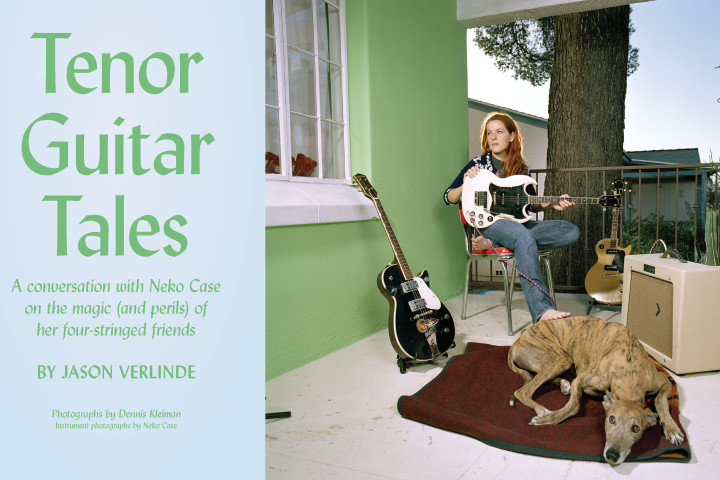Ask anyone starting out and you’ll hear that playing a guitar hurts. Ask a regularly-gigging pro guitarist? They’ll tell you that it hurts, too.
But it’s something we seldom talk about.
On May 17, Neko Case – never one to mince words – dropped a truth bomb on Twitter.
Guitar players seldom talk about arm/shoulder/neck problems. Is it a secret cause the shit HURTS?
— Neko Case (@NekoCase) May 17, 2018
The replies came from dozens of musicians, including a few artists you probably know and one (Jason Isbell) that currently graces the cover of the Fretboard Journal.
They tell you the road is lonesome but they leave out the ‘physically debilitating’ part
— Jason Isbell (@JasonIsbell) May 17, 2018
I’ll talk to you about it. Super annoying occupational hazard.
— rosanne cash (@rosannecash) May 17, 2018
Don’t ignore persistent pain-your body is trying to tell you something! Small changes in positioning/gear/technique can make a huge difference. I asked David Lindley about left hand pain playing lap steel-he told me to get a lighter bar and the pain has never come back 🙂
— deltaslide (@deltaslide) May 17, 2018
Not only guitarists, drummers have problems too. I suspect all musicians face problems sooner or later because of ergonomics.
— neowulf (@BadgerFactory) May 17, 2018
As much as guitar players love to talk about the wear-and-tear their instruments have (or don’t have), we tend not to talk so much about the toll our bodies take as musicians. It’s one thing to stop taking a Bassman to gigs to save your back but another when your back is hurting every time you pick up your Martin. But it happens.
We’ve heard this refrain from more than a few musicians lately. Chris Smither came to our office with the wrist brace he’s had to employ for the last several years. Portland-based fingerstyle whiz Eric Skye explained to us how the tendinitis in his right hand middle finger flared up during the recording of his forthcoming jazz album. “This is my fourth, and most significant, bout with tendinitis,” he says. “I had it in the other middle finger a few years ago, and both sides of my let elbow before that.” He’s currently getting steroid shots to help his finger out.
It’s no fun admitting that your favorite hobby in the world has been hobbling. But maybe we need to talk about it more. With that in mind, we’ve been asking our social media followers on their playing pains; what treatments/routines they’ve embraced; whether they’ve had to change your guitar quiver (a shorter scale? smaller-bodied guitars?); etc. We’ve received an array of responses, from the Alexander Technique to taking up the mandolin. Below are some of the best. Feel free to drop us an email and we’ll add the best submissions to the list. Maybe you can help a fellow musician out!
I would suggest seeing a Certified Hand Therapist (go to HTCC.org). This person will be either a physical or occupational therapist with expertise in treating the upper extremity. The PT’s will also be able to help with neck and back problems. I am a PT and CHT. To give you an idea of what is involved: We will discuss in detail how symptoms began, what they are, how you’ve managed them. This guides the evaluation. I will ask the musician to bring their instrument to the clinic (for pianists, I go to them), so I can analyze movements to see what may be the problem. I also complete a thorough evaluation of posture, range of motion, muscle and nerve function, practice habits, medical history, and the musician’s goals/gig & practice schedule. Sometimes the fix is as simple as warming up, rechecking your technique with a skilled instructor or in a mirror, and adjusting a practice schedule to shorter bouts over the day. My fellow CHT’s do this too. I studied piano as a kid and was inspired to learn guitar by many of my patients. I love guitar, but am not a real musician like you guys. Just don’t give up – there is help out there! –S.D.
Some tips:
– hand yoga (YouTube has a good number of exercises to use)
– Alexander technique (also YT has some vids about guitar players and posture, tension etc)
– check out Jamie Andreas web site guitarprinciples.com – lots of good info on dealing with tension/posture etc
– great book: “Indirect Procedures – a musicians guide to the Alexander Technique” – Pedro De Alcantara
– alternating cold/hot compresses on arm/wrist/fingers
– meditation
– diet: avoid inflammation causing foods – meat and alcohol are bad for tendons/ligaments
– acupuncture – I’m about to try this for RSI in my left arm/hand
– a technique my athlete son learned from a book titled “Becoming a Supple Leopard: The Ultimate Guide to Resolving Pain, Preventing Injury, and Optimizing Athletic Performance” by Glen Cordoza and Kelly Starrett; wrapping your arm in thick rubber bands (used for stretching and light resistance exercises) so as to cut off blood flow, flexing your arm until a tingling sensation in your arm occurs then removing the bands. I was amazed by how the pain and RSI feeling disappeared. It is not a permanent fix but alleviates the RSI feeling for long enough to perform with less pain. -K.C.
As someone who does 5+ gigs a week, I wouldn’t be able to play (or practice) without using these excercises/stretches every second day or every time I practice for a long time. I’ve been using them well over a decade and they make a MASSIVE difference! -B.P.
I am 45 and started playing when I was 4. I started gigging professionally when I was 14. Last year, I was hit with tendonitis in the left arm. Sometimes my index finger would be numb for days. I wasnt able to gig or practice for 3+ months. It was really scary. However, learning to warm up large muscles down to the small before a gig, as well as therapeutic yoga, has been really helpful. -P
The skinny vintage straps look cool but they must have been designed by chiropractors to drum up business. I use a 4″ leather strap and try to keep guitar weight under 9 lbs. Best straps I’ve found are from a company called Italia! -D.V.
I recently sold two nice archtops because my right shoulder hurt like hell when I tried to play them. Although I am trying to rehab my shoulder, it is easier to stick to skinny solid bodies. -D.S.
Lift weights (moderate, high frequency), eat more anti inflammatory foods. Most joint pain is caused by bad diet. -M.W.
Too many people don’t bother to invest in a quality padded strap that has some width to it, so they go out and spend $10 on the cheap skinny strap and then it cuts into their shoulder. Then they wonder why they have shoulder pain. -J.T.


